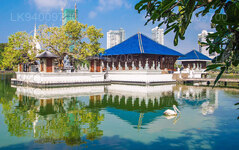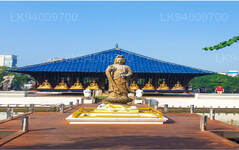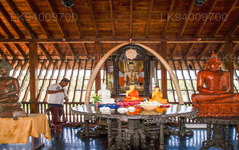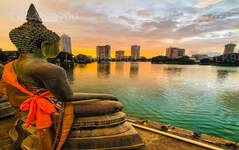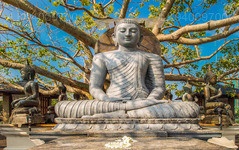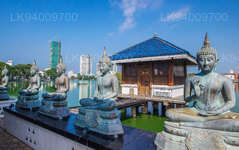
Colombo linn
Sri Lanka pealinn Colombo on dünaamiline linn, mis ühendab traditsioone ja modernsust. See uhkeldab koloniaalajastu arhitektuuri, elavate turgude ja rahulike budistlike templitega. Mitmekesise köögi, kasvava silueti ja kaunite randadega on see elav äri-, kultuuri- ja turismikeskus, pakkudes väravat Sri Lanka imede avastamiseks.
Seema Malaka
Within the heart of Colombo is the Gangarama Buddhist Temple. Built during the late 19th century for the Buddhists who lived in the capital city of Colombo; the temple sprawled over a large area of land and included several outer structures. The Seema Malaka is one of these. Originally, it was built with a foundation within the floor of Beira Lake, and was the image of stolidity. However, it was not able to withstand the marshy ground underneath the lake. By 1970 the Seema Malaka had sunk completely under the waters of Beira.
And then in 1976, Sir Geoffrey Bawa was hired to do this difficult construction design. He created three floating platforms interlinked by pontoon walkways and anchored to the base of the lake by way of stone pillars.
The light design ensured that the construction would not sink. The entire structure is connected to the shore using another pontoon bridge. He created a design that emulated the ancient monasteries of Anuradhapura and added his own signature modern twirl to it. Bawa was one of the most influential Asian architects of the mid to late 20th century and was well known for founding Tropical Modernism. This style is very apparent in the deep blue clay roof tiles of the main temple, the simplistic and yet delicate structure made of a collection of wooden spindles and banisters that lets plenty of air and light in, and the overall design that conforms to nature instead of fighting against it.Things to See
- The Central Platform: This platform has a number of Asian seated stone Buddhas along the perimeter of the platform. They are beautifully sculpted and come out well in photos. In the center is a room with slatted wooden walls. This comfortable place is used for meditation and yoga by visitors and devotees. It provides a relaxing view of the lake and its surroundings. It also has a beautiful large Buddha statue flanked by two giant elephant tusks. Before entering this room, you can take note of the Anuradhapura style dwarf guardian statues at the entrance; which are perfectly formed.
- The Northern Platform: This platform is sealed and is said to lead to the Treasury of the Truth. This houses a library of Buddhist texts and is only accessible by monks.
- The Courtyard: This is where the main part of Seema Malaka is. To one side of the courtyard, a comparatively small offshoot of the original sacred Bo tree in Anuradhapura grows out of a raised platform draped in prayer flags. It is flanked by Buddha statues of varied sizes – the biggest of which stands magnificently next to a small stupa. The courtyard has small rooms with wooden doors at the four corners. Within these are localized versions of Hindu Gods that the Buddhists worship as Devas. Just behind the main courtyard is a tier of stacked-up Buddha statues from Thailand. Close to this is the temple’s most surprising feature; a collection of vintage cars, presented by well-wishers over the years
- The Museum: On the way out of the entrance you can visit the museum. The temple museum has two big rooms overflowing with a treasure-trove of interesting objects; some collected for their symbolism, some for their artistic and/or financial value, and some just because. These include collections of ancient Sanskrit Ola leaf manuscripts, large sapphires and other precious stones, sandalwood and ivory carvings, brass statuettes of gods, jade & crystal monstrosities, elephant tusks, coins, innumerable Buddha images & statues of other Buddhist & Hindu deities, oil lamps, votive pagodas, old clocks, porcelain, ivory carvings, and even old gramophones. Overall they form what feels more like a cave of treasures that is definitely worth looking at.
Colombo ringkonna kohta
Colombo on Sri Lanka suurim linn ja kaubanduskeskus. See asub saare läänerannikul ja Sri Lanka pealinna Sri Jayewardenepura Kotte kõrval. Colombo on elav ja tegus linn, kus on segu moodsast elust ning koloniaalajastu hoonetest ja varemetest ning kus elab 647 100 inimest. Colombo metropolipiirkond, mis koosneb Colombo, Gampaha ja Kalutara linnaosadest, elab hinnanguliselt 5 648 000 inimest ja selle pindala on 3694,20 km². Colombo on mitmerahvuseline ja mitmekultuuriline linn. See on Sri Lanka rahvarohkeim linn, kus elab 642 163 inimest. Colombo elanikkond koosneb paljudest etnilistest rühmadest, peamiselt singalitest, mauridest ja tamilitest. Linnas elab ka väikeseid Hiina, Portugali, Hollandi, Malai ja India päritolu inimeste kogukondi, samuti arvukalt Euroopa väljarändajaid. Enamiku Sri Lanka ettevõtete peakontorid asuvad Colombos. Mõned tööstusharud hõlmavad keemia-, tekstiili-, klaasi-, tsemendi-, nahktoodete, mööbli ja ehete tootmist. Linna keskuses asub Lõuna-Aasia suuruselt teine hoone – Maailma Kaubanduskeskus.
Lääneprovintsi kohta
Lääneprovints on Sri Lanka kõige tihedamalt asustatud provints. Seal asub seadusandliku võimu pealinn Sri Jayawardenepura Kotte ning Colombo, mis on riigi haldus- ja ärikeskus. Lääneprovints jaguneb kolmeks peamiseks ringkonnaks: Colombo (642 km²), Gampaha (1386,6 km²) ja Kalutara (1606 km²). Sri Lanka majanduskeskusena on linnas esindatud kõik suuremad kohalikud ja rahvusvahelised ettevõtted, samuti kõik suuremad disainer- ja tänavakauplused, seega olge valmis nautima jaemüügiteraapiat lääneprovintsis. Kuna saarel on kõigist provintsidest suurim rahvaarv, asuvad seal peaaegu kõik saare parimad haridusasutused. Provintsi ülikoolide hulka kuuluvad Colombo Ülikool, Sri Jayewardenepura Ülikool, Kelaniya Ülikool, Sri Lanka Avatud Ülikool, Sri Lanka Budistlik ja Pali Ülikool, kindral Sir John Kotelawala Kaitseülikool ja Moratuwa Ülikool. Lääneprovintsis on riigis kõige rohkem koole, sealhulgas riiklikke, provintsi-, era- ja rahvusvahelisi koole.

